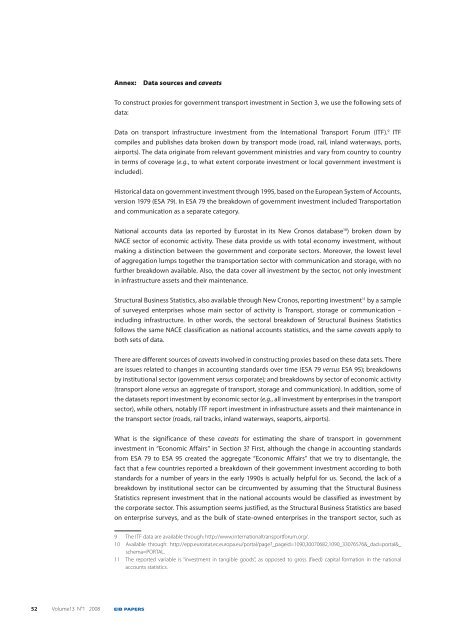EIB Papers Volume 13. n°1/2008 - European Investment Bank
EIB Papers Volume 13. n°1/2008 - European Investment Bank
EIB Papers Volume 13. n°1/2008 - European Investment Bank
Create successful ePaper yourself
Turn your PDF publications into a flip-book with our unique Google optimized e-Paper software.
52 <strong>Volume</strong>13 N°1 <strong>2008</strong> <strong>EIB</strong> PAPERS<br />
Annex: Data sources and caveats<br />
To construct proxies for government transport investment in Section 3, we use the following sets of<br />
data:<br />
Data on transport infrastructure investment from the International Transport Forum (ITF). 9 ITF<br />
compiles and publishes data broken down by transport mode (road, rail, inland waterways, ports,<br />
airports). The data originate from relevant government ministries and vary from country to country<br />
in terms of coverage (e.g., to what extent corporate investment or local government investment is<br />
included).<br />
Historical data on government investment through 1995, based on the <strong>European</strong> System of Accounts,<br />
version 1979 (ESA 79). In ESA 79 the breakdown of government investment included Transportation<br />
and communication as a separate category.<br />
National accounts data (as reported by Eurostat in its New Cronos database 10 ) broken down by<br />
NACE sector of economic activity. These data provide us with total economy investment, without<br />
making a distinction between the government and corporate sectors. Moreover, the lowest level<br />
of aggregation lumps together the transportation sector with communication and storage, with no<br />
further breakdown available. Also, the data cover all investment by the sector, not only investment<br />
in infrastructure assets and their maintenance.<br />
Structural Business Statistics, also available through New Cronos, reporting investment 11 by a sample<br />
of surveyed enterprises whose main sector of activity is Transport, storage or communication –<br />
including infrastructure. In other words, the sectoral breakdown of Structural Business Statistics<br />
follows the same NACE classification as national accounts statistics, and the same caveats apply to<br />
both sets of data.<br />
There are different sources of caveats involved in constructing proxies based on these data sets. There<br />
are issues related to changes in accounting standards over time (ESA 79 versus ESA 95); breakdowns<br />
by institutional sector (government versus corporate); and breakdowns by sector of economic activity<br />
(transport alone versus an aggregate of transport, storage and communication). In addition, some of<br />
the datasets report investment by economic sector (e.g., all investment by enterprises in the transport<br />
sector), while others, notably ITF report investment in infrastructure assets and their maintenance in<br />
the transport sector (roads, rail tracks, inland waterways, seaports, airports).<br />
What is the significance of these caveats for estimating the share of transport in government<br />
investment in “Economic Affairs” in Section 3? First, although the change in accounting standards<br />
from ESA 79 to ESA 95 created the aggregate “Economic Affairs” that we try to disentangle, the<br />
fact that a few countries reported a breakdown of their government investment according to both<br />
standards for a number of years in the early 1990s is actually helpful for us. Second, the lack of a<br />
breakdown by institutional sector can be circumvented by assuming that the Structural Business<br />
Statistics represent investment that in the national accounts would be classified as investment by<br />
the corporate sector. This assumption seems justified, as the Structural Business Statistics are based<br />
on enterprise surveys, and as the bulk of state-owned enterprises in the transport sector, such as<br />
9 The ITF data are available through: http://www.internationaltransportforum.org/.<br />
10 Available through: http://epp.eurostat.ec.europa.eu/portal/page?_pageid=1090,30070682,1090_33076576&_dad=portal&_<br />
schema=PORTAL.<br />
11 The reported variable is “investment in tangible goods”, as opposed to gross (fixed) capital formation in the national<br />
accounts statistics.

















